The Victor-Victrola Page

Victrola Design Details
1. Cabinets
2. Cranks, Brakes and Speed Controls
4. Lid Supports, Record Albums and Needle Trays
Pictures and details on some of the design features of Internal Horn Victrola phonographs. Each sequential page covers one aspect of the evolving designs. Advance to the next page via the link above or at the bottom of each page
Design Details: Cabinets
All Victrola cabinets were produced in a wide variety of finishes and colors. Please see the section on FINISHES for more information. The section below covers the basic cabinet types that were produced.
Lidless Tabletop Models
The smallest (and lowest price)
Victrolas were the lidless tabletop models, which were produced in a variety of
styles from 1911 through 1929. Typical examples would be the "VV-IV"
(shown at left), "VV-VI", and
"VV 1-1". These models have the metal dataplate located on the side of the
machine (or under the turntable in some cases), and the license label was pasted underneath. The cabinets for
most of these lidless phonographs were actually manufactured by The Jordan Woodworking
Co, or Sheip Manufacturing Co., under contract to Victor.
Tabletop Models with Lid
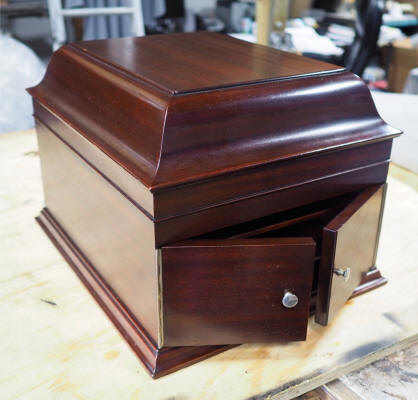 For slightly more money, a
Victrola buyer could purchase a "lidded" tabletop model. The "Victrola
XII", introduced in 1909 was the first model of this type, and was followed by
models such as the "VV-VIII", "VV-IX" (shown at left) and several others. The
popular "VV-X" and "VV-XI" models, began
their existence as a lidded tabletop model, but were quickly transformed into
popular floor models. Lidded tabletop models were made through the late
1920's.
For slightly more money, a
Victrola buyer could purchase a "lidded" tabletop model. The "Victrola
XII", introduced in 1909 was the first model of this type, and was followed by
models such as the "VV-VIII", "VV-IX" (shown at left) and several others. The
popular "VV-X" and "VV-XI" models, began
their existence as a lidded tabletop model, but were quickly transformed into
popular floor models. Lidded tabletop models were made through the late
1920's.
Upright Floor Models
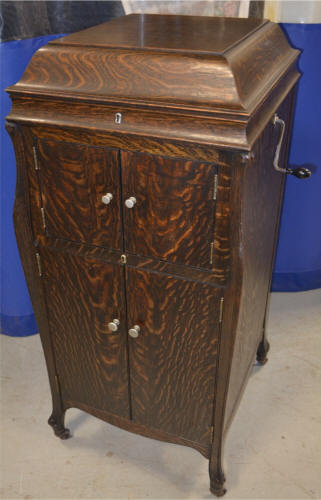 The most popular and common
Victrolas were the upright floor models. The very first Victrola used
this design in 1906, and variations of the upright floor model configuration continued
until the Orthophonics were introduced in late 1925. Popular examples
of this style include the "VV-X" and "VV-XI" (shown on left),
"VV-XIV", and
"VV-100". "Conventional door" Victrolas (left) have simple rectangular storage
and "tone doors" (the top doors, which are used to control the sound volume
during operation). Many variations of the floor cabinet design exist. The "Victrola XVI"
(initially designated as "VTLA" on the dataplate) used a pair of unusual
L-shaped storage doors with the tone door opening in the middle (right), which
are referred to as "L-door Victrolas". These were produced until 1912, when the
XVI transitioned into a conventional door design. Queen Anne type floor models are readily identified
by the use of gracefully curved long legs supporting the cabinet. Upright
Victrolas were discontinued in 1925.
The most popular and common
Victrolas were the upright floor models. The very first Victrola used
this design in 1906, and variations of the upright floor model configuration continued
until the Orthophonics were introduced in late 1925. Popular examples
of this style include the "VV-X" and "VV-XI" (shown on left),
"VV-XIV", and
"VV-100". "Conventional door" Victrolas (left) have simple rectangular storage
and "tone doors" (the top doors, which are used to control the sound volume
during operation). Many variations of the floor cabinet design exist. The "Victrola XVI"
(initially designated as "VTLA" on the dataplate) used a pair of unusual
L-shaped storage doors with the tone door opening in the middle (right), which
are referred to as "L-door Victrolas". These were produced until 1912, when the
XVI transitioned into a conventional door design. Queen Anne type floor models are readily identified
by the use of gracefully curved long legs supporting the cabinet. Upright
Victrolas were discontinued in 1925.
Hump-Back Console Models
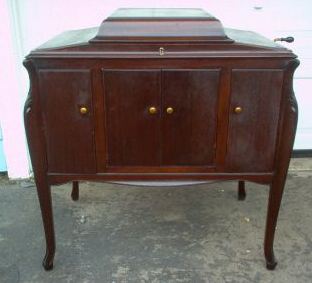 In 1921, Victor
introduced a new style of Victrola, which has been nicknamed the
"humpback" console configuration. The popularity of the upright floor
models had been decreasing, and the humpback was designed to provide a more
modern style choice. While briefly popular when first released, the humpback never
approached the
success of the upright or the flat-top consoles.
Examples of this design are the "VV-300", "VV-240" and "VV-260" (picture at
left). Hump-back models were
discontinued in 1925.
In 1921, Victor
introduced a new style of Victrola, which has been nicknamed the
"humpback" console configuration. The popularity of the upright floor
models had been decreasing, and the humpback was designed to provide a more
modern style choice. While briefly popular when first released, the humpback never
approached the
success of the upright or the flat-top consoles.
Examples of this design are the "VV-300", "VV-240" and "VV-260" (picture at
left). Hump-back models were
discontinued in 1925.
Flat-Top Console Models
To stimulate sales,
Victor introduced the "Flat-Top" consoles in 1922, which were an
immediate success. These modern-looking phonographs were amongst the most
popular Victrolas of the early 1920's. Examples are the "VV-210" (left),
"VV-215" and
"VV-220".
"Art Case" Models
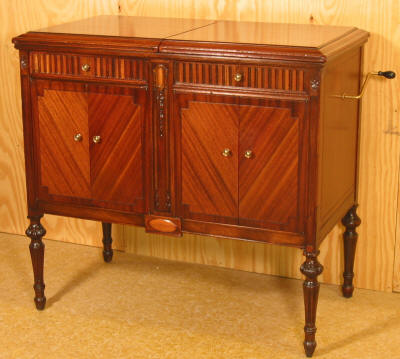 Phonograph
sales began slowing significantly in the latter part of 1924, so Victor
introduced a series of "Art Case" models, which were priced above standard
models, but still considered to be affordable. These were produced in both the
"console" and "upright" styles, and featured deluxe (machined) carvings and
details, along with fine veneers. This was at a time when radio began to
overtake phonographs as teh preferred choice for home entertainment, and the Art Case machines (with the
exception of the "VV-405") did not sell very well. Most were actually
sold during Victor's "Half-Price" sale in the summer of 1925. Examples would
include the "VV-410" (left), "VV-350", and "VV-370"
(right).
Phonograph
sales began slowing significantly in the latter part of 1924, so Victor
introduced a series of "Art Case" models, which were priced above standard
models, but still considered to be affordable. These were produced in both the
"console" and "upright" styles, and featured deluxe (machined) carvings and
details, along with fine veneers. This was at a time when radio began to
overtake phonographs as teh preferred choice for home entertainment, and the Art Case machines (with the
exception of the "VV-405") did not sell very well. Most were actually
sold during Victor's "Half-Price" sale in the summer of 1925. Examples would
include the "VV-410" (left), "VV-350", and "VV-370"
(right).
Radio Adaptable Models ("S" prefix)
When
radio started providing some serious competition for phonographs, Victor
made an attempt to "get on the bandwagon" and offer Victrolas that could be
adapted to include a radio. Since Victor did not produce radios in 1924, they
modified the cabinets of some of their more popular console models so that
the user could add an aftermarket radio, and have an "entertainment center".
Dealers who also sold radios would often integrate the
them into a Victrola cabinet for the customer. It was not a convenient setup however. The user had
to remove the soundbox from the tonearm and replace it with a
electromagnetic driver, thus using the Victrola horn as a "speaker". The radio was
then powered-up with external batteries. Results were often marginal, since
the phonograph horns were not originally designed to function in this manner.
The Victor factory did not install radios into their cabinets;
therfore "S" model Victrolas were shipped with a "blanking plate" covering the radio section on
the left of the cabinet. If the dealer or buyer did not add the radio, then
the machine would remain with the blanking plate in-place. Most of these
models were sold during Victor's "Half Price Sale" of 1925, since they were
not big sellers when introduced. Radio Adaptable models could be readily
identified by an "S" prefix before the model number, and by the fact that
there are two independent opening lids. Examples are the "VV-S-215",
"VV-S-410" and "VV-S-405" (left). The view
inside the cabinet (right) shows the radio blanking plate on the left side
of the cabinet; this example never had a radio added, which was a common
occurrence.
Period Models
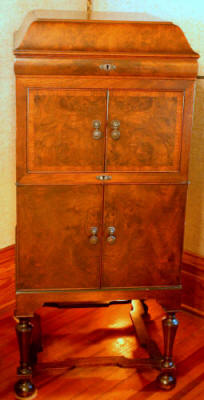 Victor's most elaborate
and expensive machines were the "Period" models, produced between 1917
and 1924. These were made in very limited quantities, and came in both upright
(left) and console (right) configurations. Most Period Victrolas had elaborate carvings, exotic woods and
special finishes in their design. The Period machines
were designated by model names such as "Hepplewhite", "Sheraton" or
"Queen
Anne". These are amongst the most desirable and valuable Victrolas.
Victor's most elaborate
and expensive machines were the "Period" models, produced between 1917
and 1924. These were made in very limited quantities, and came in both upright
(left) and console (right) configurations. Most Period Victrolas had elaborate carvings, exotic woods and
special finishes in their design. The Period machines
were designated by model names such as "Hepplewhite", "Sheraton" or
"Queen
Anne". These are amongst the most desirable and valuable Victrolas.
Special (SP) Models
Victrola
"SP" (Special) models were custom-built, made-to-order machines which
were either designed specifically for major retailers (e.g. Macy's) or for a
particular customer who wanted a phonograph to match their decor. Most SP's were
high-priced, ornate machines, and often are "one-of-a-kind" designs. However,
some are relatively plain and unexceptional, and were apparently built in
significant numbers. Victor proudly advertised that they would build a cabinet
to suit any buyer (if they were willing to pay the price), but some were
obviously built for resale by large department stores who wanted to offer a
unique product that could not be found at the local Victor dealer. Cabinet
styles vary immensely, from large elaborate designs to the most basic
configurations. Each unique style of the "SP" models was designated by an ID
number, e.g. "SP-90", followed by a serial number.
Orthophonic Models
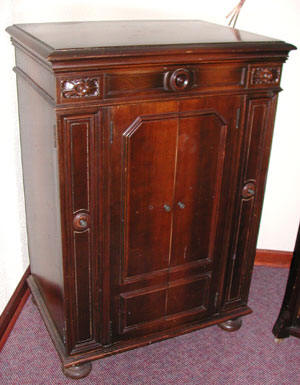
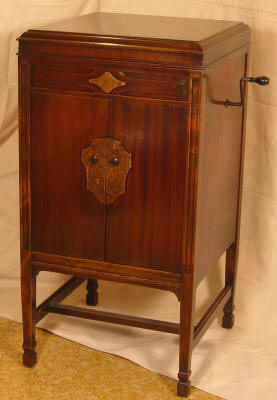 With
the introduction of the Orthophonic Victrolas in 1925, the old upright and
console designs were eliminated in favor of a more contemporary appearance,
which used Renaissance, Colonial, and similar stylistic influences. Orthophonic
models still used acoustic reproduction (no electronics), but with larger, more
technically sophisticated horns and soundboxes.
These
machines appeared in a variety of shapes and sizes, typically with a blended-stain
finish. Ornate hand carvings were eliminated, and the veneers were not of the same
quality as were previously used, making the new models more price-competitive
with other phonograph makers. The first
Orthophonics used a name, such as "Consolette", "Granada" or "Credenza"
(right), rather than a model-number identification. Later versions used
model numbers such as "VV 4-3", "VV 4-7 (right)", and "VV
8-35". Some models provided an automatic record changer. Orthophonic Victrolas were produced
until 1929.
With
the introduction of the Orthophonic Victrolas in 1925, the old upright and
console designs were eliminated in favor of a more contemporary appearance,
which used Renaissance, Colonial, and similar stylistic influences. Orthophonic
models still used acoustic reproduction (no electronics), but with larger, more
technically sophisticated horns and soundboxes.
These
machines appeared in a variety of shapes and sizes, typically with a blended-stain
finish. Ornate hand carvings were eliminated, and the veneers were not of the same
quality as were previously used, making the new models more price-competitive
with other phonograph makers. The first
Orthophonics used a name, such as "Consolette", "Granada" or "Credenza"
(right), rather than a model-number identification. Later versions used
model numbers such as "VV 4-3", "VV 4-7 (right)", and "VV
8-35". Some models provided an automatic record changer. Orthophonic Victrolas were produced
until 1929.
Electrola / Orthophonic Combination Console Models
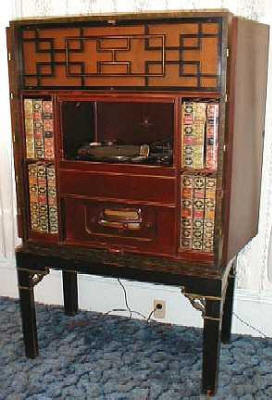 In 1925,
Victor began producing radio and phonograph combinations, which utilized
RCA-built radios (RCA was not affiliated with Victor at that time). These early
"entertainment centers" were produced in a variety of shapes and sizes. Many
of these systems used phonographs with hand-wound spring motors (and battery powered
radios) for customers who did not yet have electrical service in their homes.
Other models used AC or DC voltage from home electrical outlets to power the
components. Some provided just a phonograph with electrical amplification. The
high-end models included automatic record changers and built-in radio antennas.
Some are denoted as "Orthophonic" models, and others as "Electrolas", depending
on what type of amplification process was involved for the phonograph (acoustic
vs. electronic). These phonographs came in a huge variety of cabinet designs,
but typically had a blended mahogany or walnut finish.
NOTE: "Electrola" models produced prior to 1918 were simply
standard upright Victrolas with an electric motor option, rather than the usual
spring-wound motors.
In 1925,
Victor began producing radio and phonograph combinations, which utilized
RCA-built radios (RCA was not affiliated with Victor at that time). These early
"entertainment centers" were produced in a variety of shapes and sizes. Many
of these systems used phonographs with hand-wound spring motors (and battery powered
radios) for customers who did not yet have electrical service in their homes.
Other models used AC or DC voltage from home electrical outlets to power the
components. Some provided just a phonograph with electrical amplification. The
high-end models included automatic record changers and built-in radio antennas.
Some are denoted as "Orthophonic" models, and others as "Electrolas", depending
on what type of amplification process was involved for the phonograph (acoustic
vs. electronic). These phonographs came in a huge variety of cabinet designs,
but typically had a blended mahogany or walnut finish.
NOTE: "Electrola" models produced prior to 1918 were simply
standard upright Victrolas with an electric motor option, rather than the usual
spring-wound motors.
Portable Models
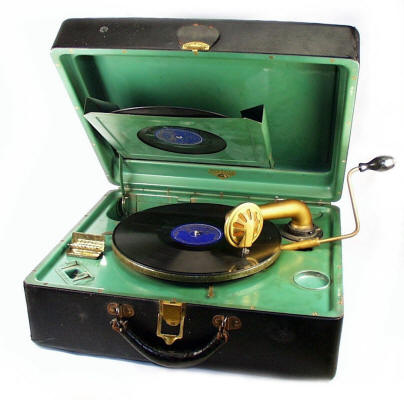 These machines were designed in a suitcase configuration,
for ease in carrying. A few of the popular models include the "VV-50",
"VV 2-35" (left),
and "VV 2-55". Portables
were not introduced until the early 1920's, in response to an influx of new
competition. They were vastly improved in 1927, and could provide
remarkably good reproduction.
These machines were designed in a suitcase configuration,
for ease in carrying. A few of the popular models include the "VV-50",
"VV 2-35" (left),
and "VV 2-55". Portables
were not introduced until the early 1920's, in response to an influx of new
competition. They were vastly improved in 1927, and could provide
remarkably good reproduction.


